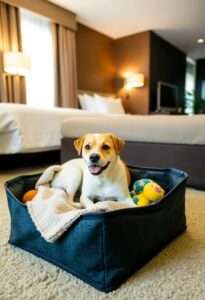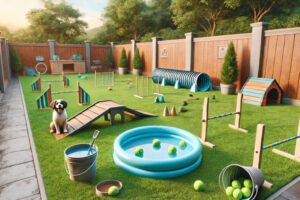How to Create the Best Pet Home in 2025 – A Complete Guide for Owners
Introduction
Welcoming a pet into your life is one of the most rewarding choices you’ll ever make. In 2025, pets are no longer just companions—they’re family members who deserve love, comfort, and safety. Creating the best living environment for them goes beyond food and shelter. It’s about building a pet home that promotes happiness, health, and bonding. Whether you’re adopting your first furry friend or upgrading your current setup, this guide will walk you through everything you need to know.
From choosing the right living space to setting up play areas, training zones, and wellness-friendly designs, we’ll cover it all. By the time you finish this guide, you’ll know exactly how to create a lifestyle that keeps your pet comfortable while making life easier for you.
Why Creating a Comfortable Space Matters
A pet’s surroundings directly affect their health, behavior, and emotional well-being. Just like humans, pets thrive in environments where they feel secure, and cared for. If their space is cluttered, unsafe, or unstimulating, they may become stressed, destructive, or anxious. On the other hand, a thoughtful home setup can encourage positive behavior, reduce stress, and improve your bond with your pet.
1. Essential Elements of a Perfect Pet Home
Designing a proper pet home involves more than setting up a bed and food bowl. It’s about creating zones that support every aspect of your pet’s daily life—eating, playing, resting, and exploring.
Key elements to include are:
- A cozy and safe resting spot
- Access to fresh food and water
- Designated play and enrichment areas
- Safety-proofed rooms
- Clean and hygienic spaces
- Access to outdoor or exercise-friendly areas
By focusing on these essentials, you lay the foundation for a balanced and healthy environment.

2. How to Choose the Right Space for Your Pet
The first step in designing a pet-friendly home is selecting the right location. Consider your pet’s size, breed, and energy levels. A large dog might need more open space for movement, while a cat may prefer vertical climbing areas.
Some tips:
- Pick a quiet corner for resting.
- Avoid high-traffic zones for food and water.
- Choose areas with natural light.
- Keep fragile or toxic items out of reach.
The right space creates a sense of ownership for your pet and helps them feel secure.
3. Safe and Functional Furniture Choices
Your furniture plays a huge role in making your home pet-friendly. In 2025, more brands are offering stylish, durable, and pet-safe furniture.
When choosing furniture:
- Go for scratch-resistant fabrics.
- opt for washable covers.
- Avoid sharp corners.
- Invest in multi-purpose furniture (like a bed that doubles as a pet crate).
These small adjustments can transform your living room into a comfortable zone for both you and your furry friend.
4. Feeding Area Setup in a Pet Home
Every animal needs a safe, accessible, and clean place to eat. Setting up a dedicated feeding area in your pet home helps establish routine and prevents mess.
Consider:
- Raised feeding bowls for large dogs.
- Non-slip mats to prevent spills.
- Automatic feeders and water dispensers.
- A quiet location away from noise.
This ensures your pet eats comfortably and without stress.
5. Creating a Resting and Sleeping Zone
A dedicated resting spot is one of the most essential areas in any home designed for pets. Pets also need a cozy spot where they can feel safe and happy. Dogs, cats, rabbits, and even small pets like guinea pigs all require different types of resting areas, but the principle is the same: comfort and security.
For dogs, choose a soft, well-padded bed and position it in a calm, low-traffic corner of your home. Senior dogs benefit greatly from orthopedic beds that provide extra support and comfort. Cats, on the other hand, often love elevated perches or enclosed beds where they can hide and feel secure.
By giving your pet a designated sleeping spot, you reduce anxiety and teach them boundaries within your home. A comfortable rest zone is a crucial building block in every well-designed pet home.
6. Designing Play and Exercise Areas
Regular physical and mental activities are essential to keep pets happy, active, and stress-free. Lack of activity can lead to boredom, stress, and destructive behavior. In 2025, many owners are blending indoor and outdoor spaces to create versatile play zones.
- Indoor play areas: For cats, install climbing towers, scratching posts, and interactive toys. For dogs, dedicate a small indoor corner with chew toys, puzzle feeders, and space for basic training drills.
- Outdoor play areas: If you have a yard, make it pet-safe by securing fences and removing harmful plants. Add agility equipment or tunnels for dogs, while cats can benefit from outdoor enclosures or “cations.”
Play and exercise areas aren’t just for fun—they support your pet’s mental development, strengthen your bond, and help burn energy in positive ways.

7. Modern Pet care with the latest Gadgets
Advances in technology have completely changed the way we look after and interact with our pets. In 2025, there are countless smart gadgets designed to make your pet home more functional and interactive.
Some of the most useful include:
- Automatic feeders – Ensures your pet gets meals on time even when you’re away.
- Smart water fountains – Help maintain clean, circulating water and encourage pets to drink more often.
- Cameras with two-way audio – Lets you check on your pet and talk to them remotely.
- Automatic litter boxes or self-cleaning pads – Great for hygiene and convenience.
- Fitness and health trackers for pets – Help you monitor their daily activity levels, overall well-being, and even location in real time.
While these tools can’t replace love and care, they make managing your pet’s daily needs easier and more reliable.
8.How to Pet-Proof Your Home
Just like baby-proofing for children, pet-proofing your house is a must. It prevents accidents, keeps your pet safe, and saves your belongings from damage.
Tips for effective pet-proofing:
- Keep electrical cords hidden or covered.
- Store cleaning supplies and medications out of reach.
- Block off unsafe areas like balconies or staircases.
- Use pet gates to manage movement indoors.
- Secure trash bins to prevent scavenging.
A properly pet-proofed home lets your furry friend explore safely, while giving you peace of mind that your space is both secure and practical.
9. Training and Behavior Management
A successful pet environment doesn’t just rely on physical setup—it also requires consistent training and discipline.
Reward good behavior: With positive reinforcement such as treats, praise, and engaging toys.
Consistency: Maintain the same rules in every part of the home.
Dedicated training areas: Create a small training corner with minimal distractions.
Behavioral enrichment: Rotate toys, provide puzzle feeders, and teach new tricks to keep their minds engaged.
Adding training to your pet’s daily schedule helps reduce stress and builds a stronger bond. A structured approach turns your home into more than just shelter—it becomes a true learning space for your companion.
A properly pet-proofed home lets your furry friend explore safely, while giving you peace of mind that your space is both secure and practical.
10. Hygiene and Cleaning in a Pet-Friendly Home
Maintaining cleanliness is often one of the toughest responsibilities for pet owners. Pets shed hair, track dirt indoors, and sometimes have accidents. Without a solid cleaning routine, your home can quickly become messy and unhygienic. But with the right approach, you can maintain a fresh and healthy environment for both you and your furry friends.
- Regular grooming: Brush your pets frequently to reduce shedding. For long-haired dogs and cats, daily brushing keeps hair under control.
- Vacuuming and sweeping: Invest in a vacuum designed for pet hair. Robotic vacuums are also a huge help in 2025 for busy owners.
- Washable covers: Use machine-washable beddings, slipcovers, and rugs in high-pet-traffic areas.
- Odor control: Use pet-safe air purifiers, baking soda for carpets, and natural cleaning sprays to keep odors away.
- Dedicated cleaning supplies: Keep pet-specific wipes, stain removers, and sanitizers on hand.
Maintaining hygiene isn’t just about aesthetics—it also helps prevent health issues for your pets. A clean pet home is a healthier one.

11. Seasonal Adjustments for a Pet-Friendly Home
Like people, pets are also influenced by seasonal shifts in weather and environment. Creating an adaptable environment is key to keeping them comfortable all year round.
- Summer: Ensure plenty of ventilation and hydration. Cooling mats and shaded resting spots are essential. Steer clear of walking dogs on overheated pavements, as it can injure or burn their paws.
- Winter: Provide warm bedding, draft-free resting zones, and cozy blankets. Small breeds and short-haired pets may benefit from sweaters or heated pads.
- Monsoon (for tropical regions): Keep areas dry, check for ticks or fungal infections, and provide indoor play alternatives during heavy rains.
- Spring/Fall: Allergies can affect pets too, so vacuum frequently and keep windows screened.
Making small seasonal adjustments ensures your pet home remains safe and comfortable regardless of the weather outside.
12. Affordable Ways to Build a Pet Home
Building the best living space for your pet doesn’t always mean spending thousands of dollars. With creativity and planning, you can design a budget-friendly yet comfortable setup.
Some cost-effective strategies include:
- DIY furniture: Old wooden crates can become pet beds or toy storage units.
- Upcycling: Turn unused shelves into cat climbing stations.
- Start with a minimalist setup—focus on essentials like a bed, feeding area, and safety measures—then add extras later.
- Thrift shopping: Many thrift stores and online platforms offer second-hand pet furniture in excellent condition.
- Multi-use products: Choose items that serve more than one purpose, such as a crate that doubles as a side table.
Remember, a loving atmosphere matters more than expensive décor. Even a simple, thoughtful arrangement can make your pet feel truly at home.
13. Nutrition and Feeding Habits
Nutrition is the foundation of good health. In 2025, pet nutrition has become more advanced, with owners opting for natural, personalized diets. But no matter what food you choose, the way you organize mealtime matters too.
- Fresh water: Always keep water bowls filled with clean, fresh water. Smart fountains help maintain hydration.
- Scheduled feeding: Stick to consistent meal times to regulate digestion and behavior.
- Safe storage: Keep dry food in airtight containers to preserve freshness.
- Offer a varied diet: By combining dry food, wet meals, and natural treats to support complete nutrition.
- Food safety: Avoid human foods like chocolate, onions, grapes, and caffeine, which are toxic to pets.
Designating a proper feeding station in your pet home ensures cleanliness, routine, and better health outcomes.
14. Exercise and Outdoor Adventures
While indoor enrichment is important, pets—especially dogs—thrive on outdoor activity. Walking, running, or playing outside keeps them physically strong and mentally stimulated.
Some tips for outdoor engagement:
- Daily walks: Minimum 30 minutes for dogs (depending on breed).
- Interactive play: Frisbee, fetch, or agility training.
- Exploration: Allow supervised sniffing walks to stimulate senses.
- Travel: Pet strollers, car carriers, and portable water bottles make outdoor trips safer.
- Safety: Always use leashes, collars with ID tags, or GPS trackers.
Outdoor exercise complements the comfort of your pet home by giving your furry friend the balance of indoor security and outdoor exploration.

16. Bonding Activities at Home
A home isn’t only made of walls and décor—it’s the place where bonds are built and relationships flourish. Spending quality time with your pet inside your home strengthens trust, reduces anxiety, and builds lasting memories.
Bonding activities to try:
- Interactive games: Hide-and-seek with treats, laser pointer chases for cats, or puzzle toys.
- Training sessions: Teach new tricks or reinforce good behavior with positive reinforcement.
- Cuddle time: Never underestimate the power of relaxing together on the couch.
- Music or TV for pets: Some pets respond well to calming music or pet-centered TV shows when you’re busy.
- DIY play projects: Create obstacle courses or treasure hunts indoors.
Your pet home should be more than shelter—it should be a hub for joy, learning, and companionship.
17. Travel and Mobility Solutions Inside the Home
Sometimes you’ll need to move your pet around the house or even prepare for outdoor trips. A well-planned pet-friendly home includes convenient travel and mobility setups.
- Portable carriers: Keep lightweight carriers handy for cats and small dogs.
- Strollers: Pet strollers are popular in 2025 for urban environments where walking long distances isn’t always practical.
- Car safety: Dedicated storage for car seats, harnesses, and seat covers ensures safe travel readiness.
- Indoor mobility tools: Gates and playpens allow you to control movement without stress.
By integrating these solutions, your home stays ready for both daily convenience and sudden trips.
18. Future Trends in Pet Homes (Beyond 2025)
Looking ahead, pet care is evolving alongside technology and lifestyle changes. Future pet homes may include:
- AI-enabled feeders can automatically adjust meal portions according to your pet’s health and dietary needs.
- Biometric collars that monitor heart rate, stress, and hydration.
- Using eco-friendly, sustainable materials in pet furniture and toys helps create a greener, healthier lifestyle.
- Pet-centered architecture, such as built-in tunnels, windows, and play zones in modern housing.
- Virtual vet consultations integrated into smart devices.
Preparing your pet home with adaptability in mind ensures you’re ready for these exciting innovations.
19. Final Checklist for the Best Pet Home
Before we wrap up, here’s a quick checklist to ensure your setup covers every aspect of a happy and healthy pet lifestyle:
✅ Cozy resting and sleeping zones
✅ Safe and clean feeding areas
✅ Indoor and outdoor play spaces
✅ Pet-proofed furniture and environment
✅ Smart gadgets for convenience
✅ Consistent training and enrichment routines
✅ Hygiene and odor management plan
✅ Seasonal adjustments for comfort
✅ Mental health and bonding activities
✅ Senior pet accessibility options
This checklist makes sure you’ve touched on every corner of pet-friendly living.
Conclusion
Creating the best home for your pet in 2025 isn’t about luxury or expensive products—it’s about thoughtfulness, planning, and love. A true pet home is one where your furry (or feathered, or scaled) companion feels safe, engaged, and cared for.
By combining smart design, modern technology, and timeless essentials like comfort, hygiene, and routine, you can transform any space into a sanctuary that supports your pet’s happiness and health. Whether you’re just starting your journey as a pet owner or looking to upgrade your current setup, remember this: the effort you put into your home environment reflects directly in your pet’s quality of life.
In the end, the greatest reward of building a pet-friendly home is seeing wagging tails, gentle purrs, and the unconditional love that pets give in return. And that’s something no gadget, no product, and no amount of money can truly replace.

